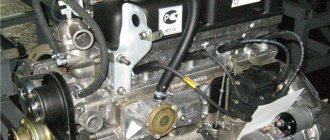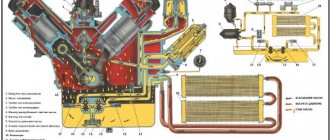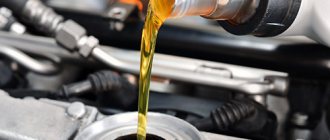If you don't change the oil for a long time: consequences
As already mentioned, the quality of diesel fuel and certain operating conditions directly affect the life of the engine oil.
If the lubricant is not changed promptly, the old oil accumulates particles of dust and dirt. Additives in oil tend to disintegrate over time, which leads to a loss of the ability to effectively lubricate and protect friction surfaces from wear, and cleaning ability decreases.
In critical cases, there is complete blockage of the oil channels of the lubrication system and the entire engine with dirty and thickened oil, which leads to serious damage to the power unit. For a diesel engine this means extremely expensive repairs.
Frequency of maintenance of diesel engines
Most diesel engine recommend changing the oil after 15 thousand kilometers . However, they do not take into account various factors that worsen the condition of lubricants:
- Low quality fuel.
- The age of the unit itself. The older the engine, the more particles from the mechanism enter the oil.
- Compliance with the thermal operating conditions of the motor. When overheated, the lubricant loses its properties.
- Dust and dirt trapped in the engine.
Thus, the frequency of replacement depends on operating conditions. Ideally, the oil should be changed every 6-7 thousand kilometers .
Choosing oil and filters
When choosing oil for a diesel engine, you need to clearly understand that lubricants for a gasoline engine and a diesel unit are different. You cannot pour lubricant intended for a gasoline unit into a diesel engine and vice versa.
Oil should be purchased from official representatives of the manufacturers.
1 liter more oil than the amount needed for the engine. This remainder can be used for topping up during vehicle operation.
Typically, the characteristics are written in the technical documentation for the car . The same applies to the filter - it must be with the characteristics specified by the engine manufacturer.
Replacement frequency
It is generally accepted that for gasoline cars and trucks the oil should be changed every 3,000 km or three months. But this does not necessarily apply to cars with diesel engines.
How often should you change the oil in a diesel engine? A car or truck with a diesel engine can drive longer without changing the oil than with a gasoline engine, depending on:
Where you drive (climate and terrain).
What you do with your vehicle (for example, frequently carry heavy loads or tow a trailer).
Whether you choose conventional, synthetic or full synthetic oil.
Let's say you make short trips around the city and rarely drive at high speeds. If this is the case, you may need to change the oil in a diesel-powered car more often than in a diesel-powered car that is typically used for highway driving.
Why? Because at lower speeds and temperatures, diesel engine oil accumulates debris and contaminants faster than if the vehicle is driven at higher speeds and in hot weather.
Important: When in doubt, consult your owner's manual and check the manufacturer's recommended oil change intervals for your diesel engine.
Below is an example of manufacturer recommendations for the 2021 Ford F-150 diesel:
Oil change interval and reasons for its wear
How often does the engine oil need to be changed? Car manufacturers give clear numbers for each type of engine. However, they do not always correspond to reality, since it is on our roads that the factors affecting the car are much more aggressive than in advanced European countries. Oil change intervals set by manufacturers are as follows:
- 5-6 thousand mileage for mineral oils;
- 10-15 thousand mileage for synthetic oils.
The use of low-quality oils has a detrimental effect on the engine.
These figures are extremely optimistic and in most cases are not reality in our conditions. Therefore, relying on manufacturers’ forecasts is highly not recommended. You need to have a keen sense of your car and at the slightest sign of wear on engine parts or the appearance of extraneous sounds in it, immediately take measures to troubleshoot and change the oil.
Factors affecting the performance of motor oil are varied. However, there are some of them that have been identified and derived based on many years of experience in operating road transport:
- car age;
- intensity of use;
- driving style;
- fuel quality;
- heavy loads;
- dust and road pollution.
Return to contents
The role of motor oil in the operation of internal combustion engines
It doesn't matter what power unit is in the car. The procedures for changing oil in gasoline and diesel engines are no different. Why does a motor need lubrication? Without car oil, it is impossible to use the car normally.
The consumable provides lubrication of all engine parts and components. Every internal combustion engine contains a large number of moving parts that interact with each other.
Imagine that a car is driving at full speed, and suddenly all the oil in its engine evaporates. Parts will begin to hit, cracks and chips will form. The same thing happens when there is insufficient quantity of lubricating fluid or a decrease in its technical characteristics.
For this reason, oil change intervals must be observed. This is the only way to avoid problems with the engine.
What is the oil change interval? Car manufacturers specify this in the owner's manual. Often the dates they indicate are far from reality, because Russian road surfaces differ from ideal ones. Typically, car manufacturers indicate the following lubricant replacement periods:
- mineral water - from 5,000 to 6,000 km;
- synthetics - from 10,000 to 15,000 km.
There are many factors that affect the service life of a motor oil:
- car production date;
- intensity of operation;
- driving style;
- fuel characteristics;
- degree of load;
- road dust and dirt.
Oil change procedure
When changing engine fluid on diesel engines, the sequence of actions must be strictly followed. Failure to follow a logical sequence when performing a series of actions can render the motor inoperative. Repairing it will be difficult, and the car dealer will refuse you warranty service. It would be a good idea to keep the technical documentation of the car with you, which will serve as a hint in case of force majeure.
When changing consumables, the step-by-step instructions are as follows:
- Unscrew the filler valve cap (it usually unscrews counterclockwise);
- Drain the oil into the pan;
- Remove the oil filter (it is removed with a special oil puller, its serial number is stamped on the filter housing);
- Replace the engine fluid filter (Do not leave it in place, as washing it cannot be cleaned.);
- There are gaskets on the valve covers that need to be replaced;
- Replace the spacer rings on the engine fluid fill valve (over time they crack and may fall off);
- Screw the cap onto the drain valve;
- Pour in new engine mixture;
- Make sure that the lubricant level is below the maximum value;
- Close the fill valve;
- Start the engine for 1-3 minutes;
- Restart the engine;
- Reset the maintenance sensor (to reset it, you need to turn off the engine, then remove the fuse, which is located on the dashboard in the radio compartment, then insert it back, turn on the engine);
- This completes the oil change procedure.
Fuse in the radio compartment
Fuse in the radio compartment
Depending on the brand, model, the fuse diagram may differ. In order to find out which fuse to remove, you should look at the technical documentation of the machine. In it you will find a description of all fuses, their function, purpose.
What happens if you pour oil into a diesel engine?
In general, if car owners who specifically add engine oil a little above the norm or to the maximum mark on the dipstick, arguing that the high consumption of engine lubricant is “waste.” You shouldn't do that.
The fact is that as a result of oil overflow, a diesel engine will consume more fuel - after all, excess lubricant provides additional resistance to the pistons as they move in the cylinders. The crankshaft also becomes more difficult to rotate and transmits less torque to the wheels. The car accelerates worse, reacts poorly to pressing the gas pedal - and here it is, increased fuel consumption.
In addition, when operating at high temperatures, the oil expands in volume, the pressure in the engine lubrication system increases - and the pressure on the oil seals and other sealing elements.
Over time, oil begins to flow through them , literally pushing out the seals, contaminating the engine compartment, and flowing through the dipstick. As a result, it risks getting into the cooling system, and it simply pours out.
Overfilling the oil quickly “finishes off” the oil pump and increases the formation of carbon deposits in the cylinders. Excess oil enters the exhaust system, the exhaust noticeably turns black and “heavier” due to toxic compounds, and the catalyst becomes clogged.
Therefore, if you find excess oil, you need to slightly unscrew the drain plug on the oil pan (the car is hung on a pit or raised on an overpass) and drain the excess .
You can use a syringe for pumping out oil or a regular one and a tube from a dropper to pump out oil directly from the oil filler neck.
And you can contact a service station so that specialists can pump out excess lubricant with a vacuum.
Fuel pumps and fuel injection pumps for diesel engines can be found in the catalog
Changing the oil in a diesel engine is one of the procedures that must be carried out for normal operation of the vehicle. Everyone knows the saying that a car is not a luxury, but a means of transportation. This does not apply to maintenance and consumables. Servicing a car, filling it with high-quality fuel and lubricants - all this is not cheap.
To save money, you can diagnose and repair your own car yourself. To change the lubricant in the engine, it is not at all necessary to contact a car service.
Content
Recommendations
- When using a diesel internal combustion engine, it is advisable to use the same brand of lubricant. Under no circumstances should you neglect changing the oil filter.
- If the oil fluid quickly darkens and turns black after filling, it means it is washing the engine. A change in the shade of the car oil is not considered a sign of loss of lubricant properties.
- Constant trips using the same brand of machine lubricant allow you to avoid the appearance of formations in the internal combustion engine that do not dissolve. Therefore, you do not need to wash the engine.
- In order to protect yourself from purchasing counterfeit petroleum products, purchase consumables only at official retail outlets.
- Follow the above algorithm, observing the order of all actions. Remember that you can always contact a car service. However, if you want to save your money, do everything yourself. Changing engine oil is not the most difficult procedure. Even an inexperienced car enthusiast can do it correctly.
- Always carry at least 1 liter of oil fluid with you in the trunk. It may be useful to you in an unexpected situation.
Useful recommendations for owners of diesel cars
Changing the oil in a diesel engine is the most important procedure to extend the life of the power unit. We strongly recommend that car owners use only those oils that meet all tolerances. Ideally, you need to fill in the original oil recommended by the car manufacturer. With every oil change, it is important to replace the filter in a diesel engine.
If you notice that the oil quickly darkens or even turns black almost immediately after changing, this does not indicate poor quality of the lubricant. On the contrary, when the oil darkens, it works. It contains detergent and dispersant additives that are useful for the power unit.
Constantly operating the machine with a certain type of oil from a specific brand eliminates the risk of interaction between old fluid residues and fresh fluid. This will eliminate the appearance of insoluble and dangerous deposits. Therefore, you will not need to flush the power unit when replacing the lubricant.
Replacement using special equipment
If a driver contacts a service center, most likely there will be special equipment that greatly simplifies the entire process. It looks like a flask with a funnel. To use it, the center must certainly have a lifting mechanism. To begin with, the car is driven onto a lift, raised to a level so that it is possible to place this device under it.
The funnel is located under the tray and after the lid is removed, the stream enters a special funnel and then enters the flask. Using special hoses present in the design, craftsmen remove oil from the flask.
The role of the filter in the lubrication system and its timely replacement
The filter is an extremely important element in the entire system in the engine. Due to the large number of small parts such as chips, carbon particles, dust and much more.
The engine could quickly become unusable even with good lubrication. The filter prevents small particles from penetrating to further components of the vehicle.
The fine filter, which needs to be replaced, together with the oil, consists of special cardboard paper arranged in a circle. It has one large hole and quite a few small ones around. The oil enters the filter through a large hole, in a large flow for better cleaning, and leaves it through small ones, after it has been cleaned.
Inside the lubrication system there is another coarse filter, which is installed inside the pan on the pump itself. It does not need to be replaced as often and is a wide plate with a metal mesh stretched around its perimeter. It protects the oil from getting quite large metal impurities, these can be large chipped pieces of metal, carbon deposits that have gotten inside the pan and much more.
In order for the engine to always be in good condition, it is necessary to take care of the condition of all filters in the lubrication system. If the engine is disassembled, it is worth inquiring about its condition inside the pump. If it is very worn, it is recommended to replace it or clean it thoroughly.
Cleaning the engine can be carried out using compressed air supplied under pressure. It will easily remove severe blockages inside the mesh.
How can you determine when you need to change your engine oil?
To determine for yourself whether it is worth changing the lubricant or whether you can still wait, use the following instructions. This is done using a special probe.
- Remove the dipstick from the cold car.
- Wipe the dipstick dry with a cloth.
- Place the dipstick back into the engine and wait a couple of seconds.
- Carefully pull out the dipstick and examine its tip.
There are 2 marks on the end of the dipstick. The upper mark is the maximum level of oil that should be in the engine, and the lower mark is the minimum level. So the oil level should be in the middle or closer to the maximum mark. The less lubricant in the engine, the faster it deteriorates. Therefore, it is recommended to fill motor oil closer to the maximum mark on the dipstick.
If the oil is at the lower limit, then it must be urgently topped up or replaced if it is already old.
Pay attention to the oil itself. If it has become more liquid and literally flows from the dipstick, it means that the amount of additives and dirt in it has become less. The same applies if the lubricant is tar-like. If the color of the lubricant is yellowish-brown, it means there is no carbon deposits or other engine wear products. If the car oil has acquired a black tint, then it must be changed as soon as possible.
Popov Andrey Gennadievich
Car mechanic, 19 years of experience
Ask a Question
There is also a test method by spreading it on a paper napkin. If you drop oil on it and a huge, wet spot appears, the lubricant must be replaced immediately.
Engine oil test
In general, it is better to do such a check every thousand kilometers. This way, the car owner will better understand when he needs to change the lubricant next time.
Video: how to determine the degree of oil contamination?
Now let's move on to the engine hours - a characteristic that quite accurately shows when the oil has become “old” and needs to be replaced. A must read.
Changing diesel oil in a garage
While you can change the oil in your garage or driveway, we don't recommend it. Here are two reasons why you should leave this procedure to the professionals.
1- Convenience
While you can save money by changing the lubricant yourself, you won't save time. You will also need to learn the necessary steps and materials, purchase those materials, buy the right oil, change the oil, clean it after, and properly dispose of the discarded oil with an oil filter. Plus, you'll have to repeat almost all of these steps every time your car needs an oil change.
2- Risk
Getting your oil changed by a professional reduces the chance of something going wrong in your garage or your car because auto technicians are specially trained to change your oil correctly—they're less likely to make rookie mistakes like using the wrong lubricant or causing a leak. At the end of the day, getting your oil changed professionally will give you peace of mind.
How to get rid of used lubricant used in a diesel engine?
Do not forget about the environment because used oil must be disposed of. Under no circumstances should it be poured under bushes or anywhere else. You can use the services of special services that remove all accumulated oil from special metal barrels.
In some enterprises, workers use tricks, combining business with pleasure. They build special stoves that will be especially relevant in the winter season.
Mineral oil is environmentally friendly and therefore does not cause any harm to the atmosphere, so it can be legally disposed of by burning it inside a furnace. It turns out to simultaneously get rid of accumulated grease and still keep warm in severe frosts.
It is also not worth pouring into the street, largely due to the fact that this crime is punishable to the fullest extent of the law. If the owner of an enterprise does not worry about the environment, then he should worry about the state of his wallet, which will be subject to a quite significant fine that will not make him want to repeat this crime again.
Oil aging
Oil, like any other technical fluid, loses its properties during use; wear products and soot from fuel accumulate in it; ultimately, such old, blackened oil cannot properly lubricate the engine, which leads to rapid breakdowns. Also, the properties of the oil deteriorate due to oxidation processes, which occur even if the car is not in use or the car has minimal mileage. That is why it is recommended to change the oil, not only based on the mileage of the car, but also every two years of operation of the car.
Fuel quality
It turns out that even the quality of the fuel being poured has a direct impact on the timing of engine lubricant replacement. The sulfur content of gasoline plays a decisive role here.
With a value of more than 50 ppm, such gasoline is not recommended for use in ordinary passenger cars. When fuel burns, sulfur is converted into sulfuric acid, which enters the fuel and oxidizes the engine oil. The grease becomes like tar.
Now let's move on to existing types of engine oils.
What happens if you are late with your oil change?
It's another task on your to-do list. You convince yourself that nothing will happen to the car. You decide to wait until next week, maybe until next month, when life becomes easier and you have a free moment. In addition, you ask the question: is it necessary to change the oil every 3000 km? Putting it off can't do too much harm. Right?
Cancellation of vehicle warranty
Reduced engine performance
In addition to lubrication, oil also keeps your car's engine clean. Detergents, dispersants and other additives carry dirt and debris into the fuel filter, which is also replaced during an oil change. Once your filter becomes clogged, all that dirt is forced to circulate through the engine.
Thus, smooth, clean oil gradually becomes dirty sludge. Your engine's moving parts have to fight their way through this gunk, forcing it to work harder. As a result, your car may experience reduced torque. And the harder your engine works, the more fuel it will consume. This means that you will have to stop at gas stations more often and spend your hard-earned money.
Complete engine failure
Drive long enough without an oil change and it could end up costing you your car. Once motor oil turns to sludge, it no longer draws heat from the engine. As a result, the diesel engine can overheat and either blow out the gasket or seize.
Timely replacement and its importance
There are several types of oil you can use:
- Synthetics;
- Mineral water;
- Semi-synthetic.
Each of the oils has its own characteristics and if it is not changed in a timely manner, it begins to cope poorly with the task assigned to it. Synthetics are made from special materials in the laboratory and are not of plant origin. It has a uniform film that covers the parts of a diesel engine, does not require an additional set of additives, and also withstands quite serious temperature changes.
Mineral water is used in areas where climatic conditions do not suffer from constant change, which means it is more susceptible to wear and tear. It suffers quite a lot from changes, which means it needs additional additives. They will improve the quality and have a positive effect on the dynamics of the car.
It is worth mentioning that during the oil change process you can use all kinds of additives that are poured into the engine immediately after lubrication.
They can solve some problems that are associated with excessive fuel consumption, engine smoke and reduced compression. Compression decreases due to the fact that the cylinder walls are very susceptible to damage and microscopic cracks can form on them, which reduce compression. And a special material related to the composition of the lubricant seals the walls and eliminates cracks.
Diesel engine. Changing the oil
My life is not only connected with cars, but with repairs and maintenance. But I also have hobbies like all men. My hobby is fishing.
I started a personal blog in which I share my experience. I try a lot of things, different methods and methods to increase my catch. If interested, you can read it. Nothing extra, just my personal experience.
Attention, TODAY only!
Factors that affect the operation of internal combustion engines
The most important factor is the date of manufacture of the machine (the number of engine hours worked by the internal combustion engine), because the degree of wear of all units depends on it. The lubricant complex is no exception. The more engine hours the vehicle’s power unit has worked, the more often the oil product must be changed.
The intensity of use involves traveling long and short distances. During long trips, the engine lubricant warms up and passes through all the internal combustion engine parts, forming a film on them. During short trips, the car oil does not have time to properly lubricate all engine parts.
Driving style is also very important. Over-gassing, sudden stops, skidding - all this overloads the car's components. Car oil, designed to compensate for friction in the engine, is unable to cope with its task and is unevenly distributed among the parts. As a result, friction in the engine increases.
High-quality fuel is the key to engine health
It is well known that when low-quality fuel burns, a specific sediment appears that covers all engine parts, impeding the movement of moving elements. The deposit prevents the oil from lubricating the parts properly. In view of this, if you want to preserve the internal combustion engine and ensure its smooth functioning, use only high-quality fuel.
High loads on vehicle axles and components can lead to damage to spare parts. Traveling over rough terrain leads to loosening of the motor units and disruption of the movement of moving parts.
The dust that enters the engine causes sediment to appear on its spare parts. It, like residue from burnt fuel, interferes with the normal operation of the engine.
Types of motor oil
All basic motor lubricants are divided into the following types:
- Mineral . Created from oil. Considered a classic motor lubricant. It needs to be changed 2 times more often than synthetics. It's cheap.
- Synthetic
. Its properties are much better than mineral ones. The price is higher than the mineral one. - Semi-synthetic . Contains 2 parts mineral water and one part synthetic. This is a mixture that has an average price. You will have to change such oil more often (no more than 10-15 thousand km), and it also quickly fills with engine wear products. There is an analogue of semi-synthetics - hydrocracking oil, which lasts much longer (up to 30 thousand km, depending on the engine and fuel).
- Marked Longlife. These are oils that can be changed less frequently than conventional ones. But the vehicle and operating conditions when using such oils must strictly comply with the manufacturer’s instructions. These are criteria such as the use of high-quality fuel and consumables, the average load on the internal combustion engine and driving on the highway.
- Oils based on polyalphaolefins . They are used for racing cars. These oils have high viscosity and can withstand very low temperatures, the breakdown products are clean, the burn rate is low, and the drain interval is more than 400 operating hours. The disadvantages are an unstable oil film and a reduced friction index. The price of such lubricants is quite high.
- Esteraceae . They are expensive, but they are considered the best in a number of parameters. For example, it has a low coefficient of friction, high cleaning properties, and a high-quality oil film. According to experts, it may not cope with the standard 15,000 km due to the small amount of additives. It is recommended to use this lubricant after long-term use of mineral and semi-synthetic oil in order to properly “flush” a dirty engine.
- Polyglycolic . They are considered the best. Finding them is quite difficult, so the price is also quite high. They have a low coefficient of friction, and the additives retain their properties for a long time. The oil change period here is higher than usual. The most famous oil is called Kroon Oil Poly tech.
Now I will answer in detail the most popular questions that are asked about changing the engine oil.
Why does diesel oil need to be changed more often?
The service life of a diesel engine depends on correctly selected engine oil and compliance with the recommendations specified in the operating manual. According to the regulations for Europe, the oil in a diesel engine is changed every 10 thousand kilometers traveled, and on gasoline engines the scheduled replacement period allows driving about 20 thousand km.
It is worth separately taking into account that diesel fuel and gasoline in developed countries are of much higher quality than diesel fuel in the CIS. Domestic diesel fuel contains more sulfur and other undesirable impurities, which causes rapid oxidation and aging of motor oil. For this reason, dealer service centers recommend routine replacement every 10,000 km. for gasoline engines and every 7,500 km. for diesel engines. When operating a vehicle in difficult conditions (transporting goods with heavy equipment, having a loaded trailer in passenger cars, traveling short distances, sitting idle in traffic jams, etc.), this interval for a diesel engine is reduced to 5 thousand kilometers traveled.
It is a mistake to believe that the operation of modern turbodiesels on synthetic and semi-synthetic oil means that the replacement interval can be significantly increased compared to driving on cheaper mineral oils.
Synthetics and semi-synthetics differ in that they are able to maintain optimal characteristics and properties longer. Such oils more effectively protect the engine from wear over a certain service life, but this period is still limited. It turns out that the use of expensive synthetics provides better performance characteristics, but does not allow you to drive on the specified lubricant without replacement for longer than usual.
As for Longlife oils with an extended replacement interval, as well as universal oils with the possibility of simultaneous use in gasoline and diesel engines, these products were initially developed taking into account the use of high-quality diesel fuel within the framework of European standards. In the CIS, when driving with these oils, you must adhere to general recommendations, regardless of the type of oil, its features and unique properties.
We also recommend reading the article on choosing oil for a diesel engine. From this article you can learn about the basic requirements, parameters, tolerances and recommendations when selecting diesel engine oil.
How to properly add oil to the engine
If, after checking the lubricant level with a dipstick, or the dipstick is dry, the oil must be added. It is best to do this on a cooled engine. In winter, in cold weather, the diesel internal combustion engine must be warmed up so that the lubricant is liquefied, and only then (when the engine has cooled down to about 50 degrees) the engine must be topped up.
Try to ensure that the oil inside the engine and the oil being added are at the same temperature. Thus, adding a large (about a liter) amount of oil from a frozen trunk to a hot engine can end unpredictably.
Basically, from o to “max” engines contain 0.7-1 liters of oil . Your task is to add lubricant to the level so that it is marked on the dipstick exactly in the middle between the marks.
That is, in the case when the oil is low, about 300-400 ml will be enough to top up.
- Having placed the car on a level surface and waited until the engine has cooled, unscrew the oil filler cap (it is located in the upper part of the cylinder head and is most often indicated by a picture of an oil can with a drop of oil).
- Then insert a clean funnel (it can be made from a bottle, for example) into the neck. Try not to get any oil on the cylinder block or cylinder head, and if it does spill, wipe it off immediately with a dry cloth.
- You need to add oil gradually, 100-200 ml at a time. Next, wait until the oil drains into the pan - 10-15 minutes is enough, check the lubricant level with a dipstick and add another 100-200 ml if necessary.
- When the oil level on the dipstick is halfway between o and “max”, insert it firmly into the hole and screw on the oil filler cap.
Then start the engine and listen to it carefully - there should be no extraneous noise, knocking, or vibration. Check the instrument panel - the oil pressure light and the Check Engine icon should not be illuminated.
Warm up the diesel and drive the car. Then wait until the engine cools down and check the oil level again.
If the level is reduced again, and lubricant is leaking from under the covers, oil seals and seals in the engine compartment, you need to go for in-depth diagnostics. If the oil drains quickly, call a tow truck.
Useful tips
- When operating a diesel engine, it is recommended to use oil of the same brand that meets all tolerances, which was originally intended for a diesel engine (it is not universal). In parallel with changing the engine oil, the oil filter of the engine lubrication system must be changed.
- Rapid darkening and even blackening of engine oil after changing it directly indicates the active action of dispersing and detergent additives, which are necessarily included in its composition. A change in color does not mean that the lubricant has lost its properties.
- Constantly driving with oil of the same type and manufacturer eliminates the possibility of interaction between old oil residues and fresh oil and the formation of insoluble deposits in the engine. It turns out that the need to flush a diesel engine before changing the oil becomes much less relevant.
- To insure yourself against purchasing a counterfeit, buy motor oil only from an authorized dealer or at official points of sale.
How does an oil filter work?
Your oil filter does more than filter waste. Its parts work together to cleanse the oil and keep it in the right place at the right time.
Oil filter components
- Flow plate: Oil enters and exits the oil filter through a flow plate, which looks like a central hole surrounded by smaller holes. Engine lubricant passes through the smaller holes, through the filter media, and then flows to your engine through the center hole.
- Filter Material: The filter is made of synthetic fibers that serve as a sieve to trap sand and dirt in the engine oil. The material is folded to create a larger surface area.
- Rear Anti-Drain Valve: When the engines are turned off, this valve closes to prevent oil from leaking back into the oil filter from the engine.
- Pressure Relief Valve: When it's cold outside, the engine oil can thicken and force its way through the filter. The relief valve releases a small amount of unfiltered motor oil to keep your engine boosted until it warms up.
- End Discs: Two end discs on either side of the oil filter, made of metal or fiber, prevent unfiltered lubricant from entering the engine.
Of course, you don't need to memorize all of this, but understanding how the filter works will help you understand how important it is to replace it on time.










